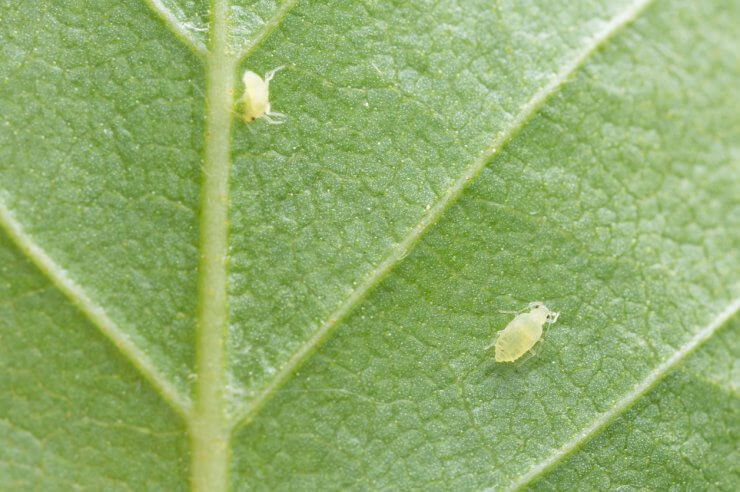
Aphid on leaf
Pea plants are relative free of diseases, especially if you use disease-resistant seeds. Aphids and powdery mildew are the most common offenders. But your pea plants can develop a few other problems, caused by bacteria, fungi, and viruses. The diseases can spread through the soil, water, air, infected tools, animals, and even gardeners themselves.
Spot diseases on your pea plants sooner so you can treat plants before they are destroyed by disease and can successfully manage symptoms. Here is a three-step approach to keeping vigilant about the presence of pea plant diseases:
- Research the Risks. Find out about pea diseases that are prevalent in your geographic area. When possible, buy disease-resistant pea plant varieties to avoid diseases in the first place—many hybrid pea varieties have been specifically designed to resist certain diseases.
- Examine Plants Daily. Check your pea plants every day to be sure no disease symptoms are present or emerging.
- Spot Diseases Early. Catch and treat disease quickly so your plants can recover and thrive.
Pea diseases can affect the leaves, pods, stems, and fruit. Here is what to look for to spot possible infection:
Pea leaves—possible disease symptoms:
- Dark green, shiny, or papery brown spots
- Yellowed, stunted, or dead-looking foliage
- Powdery leaves
- Brown blotches
- Wilting
Pea stems and roots—possible disease symptoms:
- Blackened stems
- Mold or mildew
- Stunted growth
- Brown, black, or red roots, often with outer layer peeling off
Pea pods/fruit—possible disease symptoms:
- Discolored spots
- Spotted/blotched skin
- Mold or mildew
- Misshapen or undeveloped fruit
- Dropped fruit
Make your own natural disease and pest control spray with benign materials. Mix one tablespoon of baking soda, 1/2 teaspoon of a mild dish detergent, and 2 1/2 tablespoons of olive oil in a gallon of water to make a solution that will repel all kinds of bugs, as well as a fungicide for blight and mildew on the pea plant leaves. Shake it well in your bottle before spraying, and repeat every week for it to be continuously effective.
We’re believers in not using toxic materials in the garden—they can hurt the plants, hurt the soil, damage the environment, and harm you.
Preventive measures to avoid pea plant diseases
Try some of these techniques for avoiding pea diseases in the first place:
Rotate crops regularly
Many bacteria, fungi, and viruses live in the soil for years and are just waiting to prey on your pea plants! Minimize the likelihood of these diseases when you plant peas by planting no more than once every three years in the same location.
Improve your soil composition
Before planting your peas, add a good amount of compost or organic matter to improve the soil. Extra nutrients and good aeration help grow stronger plants that will resist disease and infection.
Plant disease-resistant pea varieties
Many hybrid pea varieties have been developed specifically to resist particular pea plant diseases. You can plant disease-resistant pea varieties to always have the healthiest plants and harvest. Pea disease resistant codes are listed on seed packets or seedling containers in capital letters. They include:
F = Fusarium Wilt
B = Bacterial Blight
DM = Downey Mildew
PEMV = Pea Enation Mosaic Virus
PM = Powdery Mildew
PLR = Pea Leaf Roll Virus
Water your garden properly
Don’t underwater or overwater your pea plants. By keeping a regular watering schedule, you’ll keep your plants vibrant and healthy. Overwatering and watering directly on the plants—instead of the preferred watering method, directly at the stem on the soil—leads to consistently wet conditions, which allows bacteria, fungi, and viruses to thrive and multiply.
Destroy infected plants
Throw away or burn infected plants. Don’t keep infected plants over the winter in your garden, and don’t throw them on your compost pile. Disease-ridden plants, even when dead, will spread the disease to other plants or even your soil.
Have you had problems with diseases attacking your pea plants? What types of problems do you regularly face with your peas? Please tell us how you treat and prevent diseases for destroying your pea crop.


 Previous
Previous

